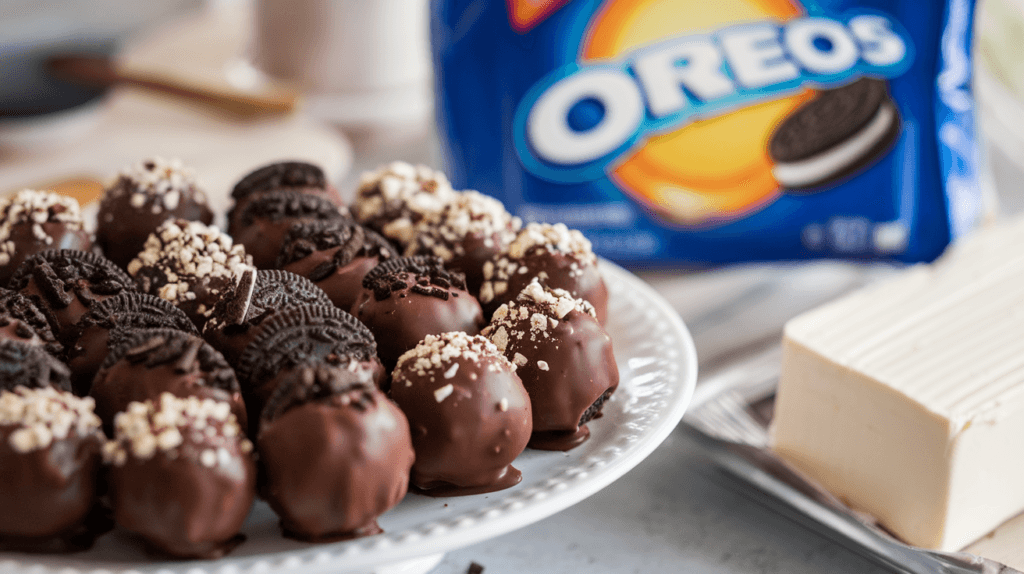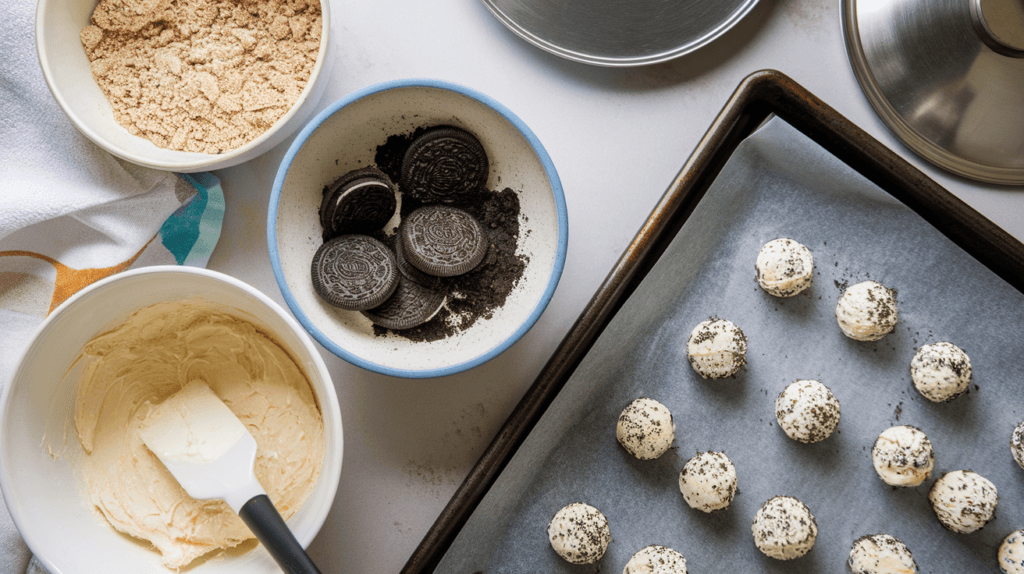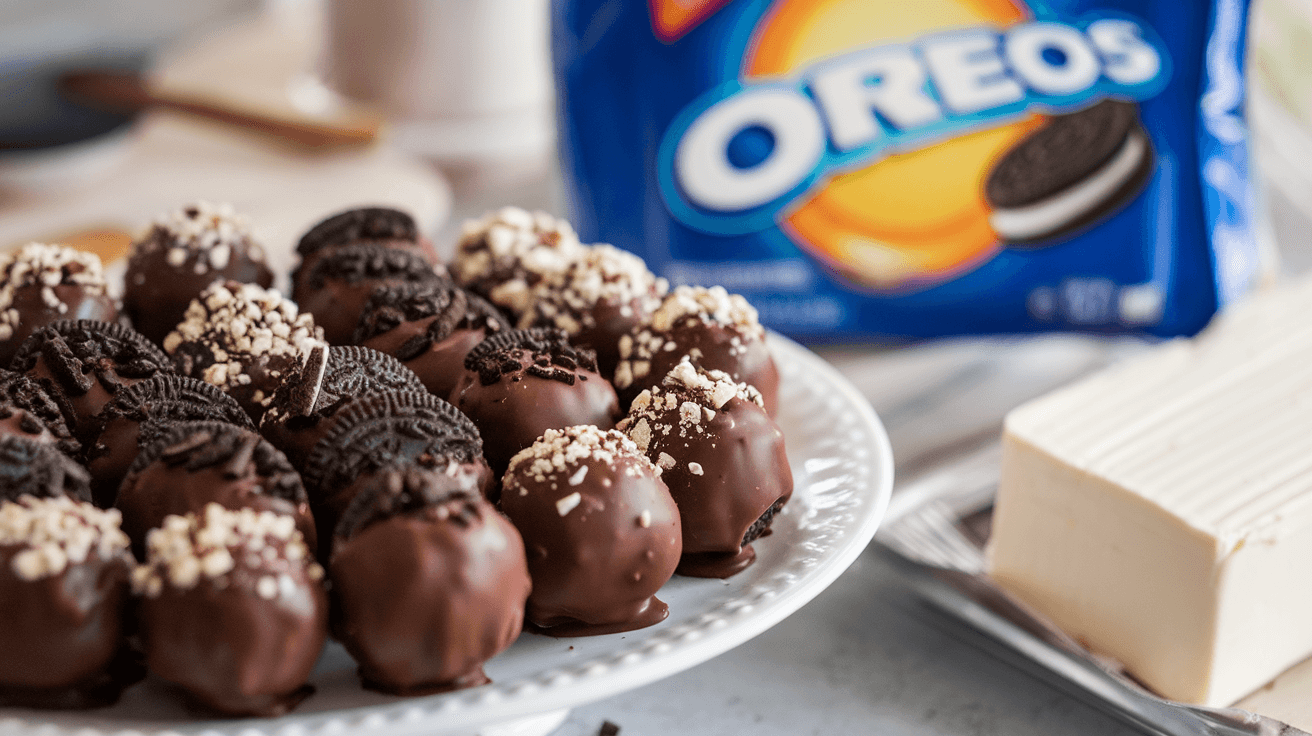Introduction

People often refer to Oreo balls as Oreo truffles, a delectable dessert that offers creamy texture, rich flavor, and easy preparation. But when it comes to storage, many wonder, “Do Oreo balls need to be refrigerated?” This question is crucial because improper storage can impact their freshness, safety, and taste. In this guide, we’ll explore the factors that determine whether Oreo balls require refrigeration and provide practical tips to keep them delicious for any occasion.
Many people frequently ask a common question about these delightful confections: Do Oreo balls need to be refrigerated? Some people believe these treats are fine at room temperature, while others argue that refrigeration is essential to maintain their freshness and safety.
This article explains the factors that determine if Oreo balls need refrigeration, highlights the best storage practices, and shares tips to keep them delicious and safe. But first, let’s take a closer look at what Oreo balls are and why they have become such a beloved dessert.
What Are Oreo Balls, and Do They Need Refrigeration?
Oreo balls are a no-bake dessert that combines crushed Oreo cookies with softened cream cheese to form a smooth, moldable dough. This mixture is then rolled into small balls and coated with melted chocolate or candy melts for a sweet and creamy finish.
Key Ingredients:
- Oreo Cookies: The star of the recipe, these cookies provide the signature chocolatey flavor and crumbly texture.
- Cream Cheese: Acts as the binder, giving the dessert its creamy consistency.
- Chocolate Coating: Adds a rich outer layer that hardens when cooled, providing a delightful crunch.
Popular Variations:
- Adding a dash of vanilla extract or peppermint flavoring to the mixture.
- Using white chocolate, dark chocolate, or colored candy melts for the coating.
- Sprinkling toppings like crushed Oreos, sprinkles, or sea salt for added flair.
These simple ingredients make Oreo balls a versatile treat, perfect for customizing to suit any occasion. However, their composition—especially the inclusion of cream cheese—plays a significant role in determining how they should be stored.
Why Refrigeration Is Important for Desserts Like Oreo Balls
Refrigeration is a crucial aspect of storing many desserts, particularly those made with perishable ingredients like cream cheese. Proper refrigeration helps to:
- Preserve Freshness: Keeping Oreo balls cool ensures they maintain their texture and flavor for longer.
- Prevent Spoilage: Ingredients like cream cheese can spoil quickly if left at room temperature for extended periods.
- Ensure Food Safety: Refrigeration inhibits the growth of harmful bacteria, reducing the risk of foodborne illnesses.
While refrigeration is generally recommended for foods containing dairy, other factors—such as the ambient temperature and the intended storage duration—can influence whether it is strictly necessary.
In the case of Oreo balls, their storage needs depend on how soon they will be consumed and the environment they are kept in. This brings us to the central question: do Oreo balls need to be refrigerated?
Do Oreo Balls Need to Be Refrigerated? Everything You Should Know
The answer largely depends on the ingredients used and the conditions they are stored in. Here are some key factors to consider:
Ingredients Matter
- Cream Cheese: As a dairy product, cream cheese is highly perishable and should be kept chilled. This makes refrigeration essential for Oreo balls, as cream cheese is a primary ingredient in the mixture.
- Chocolate Coating: While the chocolate layer provides some protection, it doesn’t replace the need for refrigeration, especially if the balls are kept for more than a day.
Storage Duration
- For short-term use (a few hours): Oreo balls can typically be left at room temperature, especially in a cool environment.
- For longer storage (more than a day): Refrigeration is strongly recommended to prevent spoilage and maintain quality.
Temperature Conditions
- In warm climates or during summer months, Oreo balls should always be refrigerated to prevent the cream cheese from softening and the chocolate coating from melting.
- In cooler environments, they might last slightly longer at room temperature but should still be refrigerated for safety.
Understanding these factors will help you decide the best way to store your Oreo balls while ensuring they remain fresh and delicious.
When you’re ready to enjoy these treats, it’s equally important to know how to store them properly. Let’s explore the best practices for refrigerating Oreo balls and other storage options.
Storage Guidelines for Oreo Balls
Proper storage is key to maintaining the quality, flavor, and safety of Oreo balls. Whether you choose to refrigerate or freeze them, following best practices will ensure these treats stay as delicious as the day they were made.
Refrigeration Guidelines
If you plan to refrigerate Oreo balls, here’s how to do it correctly:
- Use an Airtight Container: Place the Oreo balls in a single layer inside an airtight container. This prevents moisture and odors from other foods from affecting the taste.
- Separate with Wax Paper: If stacking is necessary, use wax or parchment paper between the layers to prevent sticking.
- Optimal Temperature: Keep the refrigerator set at or below 40°F (4°C) to preserve freshness.
- Keep Away from Strong Odors: Store the container away from strong-smelling foods like onions or garlic, as Oreo balls can absorb odors.
Freezing Guidelines
Freezing is an excellent option if you want to store Oreo balls for a longer period. Here’s how to freeze them effectively:
- Pre-Freeze: Place the Oreo balls on a baking sheet lined with parchment paper, ensuring they don’t touch. Freeze for 1-2 hours or until firm.
- Package for Long-Term Storage: Transfer the frozen balls to a freezer-safe bag or container. Remove as much air as possible to prevent freezer burn.
- Label and Date: Write the date on the container to keep track of storage time. Frozen Oreo balls are best enjoyed within 2-3 months.
Thawing and Serving
When ready to enjoy frozen Oreo balls, transfer them to the refrigerator and allow them to thaw slowly. Avoid leaving them at room temperature to prevent condensation, which can affect the texture of the chocolate coating.
Room Temperature Storage
While refrigeration is generally recommended, there are situations where Oreo balls can be stored at room temperature temporarily.
Short-Term Storage
- Duration: Oreo balls can safely remain at room temperature for up to 2 hours, or up to 4 hours if the environment is cool and dry.
- Conditions: Ensure the area is free from direct sunlight, high humidity, or heat sources, as these factors can cause the chocolate to melt and the cream cheese to spoil.
When Room Temperature Storage is Suitable
Room temperature storage is most suitable for:
- Immediate Consumption: If Oreo balls are being served at a party or gathering, there’s no need to refrigerate them if they’ll be eaten within a couple of hours.
- Non-Dairy Variations: For Oreo ball recipes that omit cream cheese (using alternatives like coconut cream or sweetened condensed milk), refrigeration may not be necessary.
While room temperature storage can work in specific scenarios, refrigeration is the safer option for preserving quality and ensuring food safety.
Refrigeration vs. Freezing

give me 3 tags for the article
To determine the best storage method for Oreo balls, let’s compare the pros and cons of refrigeration and freezing:
| Aspect | Refrigeration | Freezing |
|---|---|---|
| Shelf Life | Up to 1 week | Up to 3 months |
| Texture Preservation | Maintains original texture | May slightly alter texture after thawing |
| Convenience | Ready to eat anytime | Requires thawing before serving |
| Suitability | Ideal for short-term storage | Perfect for long-term storage |
Recommendation
- For immediate or short-term use, refrigeration is the best choice to keep Oreo balls fresh and ready to enjoy.
- For bulk preparation or extended storage, freezing is a better option, provided you follow proper freezing techniques.
Each method has its benefits, and your choice will depend on how soon you plan to serve or consume the Oreo balls. Up next, we’ll discuss some common mistakes to avoid when storing Oreo balls to ensure they remain perfect.
How to Properly Refrigerate Oreo Balls

Refrigerating Oreo balls is a straightforward process, but a few details can make a big difference in preserving their texture and taste. Here’s a step-by-step guide to ensure your treats stay in prime condition:
1. Cool Before Refrigeration
After preparing and coating your Oreo balls with chocolate, allow them to set completely at room temperature or in the refrigerator before storing them. This prevents condensation from forming and affecting the chocolate’s texture.
2. Choose the Right Container
Opt for an airtight container with a secure lid. This keeps the Oreo balls fresh and prevents them from absorbing odors from other foods in the fridge.
3. Layer with Care
If you need to stack the Oreo balls, place a sheet of parchment or wax paper between layers. This prevents the balls from sticking to one another or losing their chocolate coating.
4. Refrigerate Promptly
Store the container in the refrigerator as soon as the Oreo balls are set. Avoid leaving them out for too long, especially in warm or humid conditions, as this increases the risk of spoilage.
5. Check for Odors
Ensure that your fridge is free of strong odors. Foods like onions, garlic, or leftovers can affect the flavor of your Oreo balls if they aren’t stored in a completely airtight container.
Proper refrigeration not only keeps Oreo balls fresh but also ensures they maintain their rich flavor and creamy texture for several days.
How Long Can Oreo Balls Be Refrigerated?
Oreo balls can typically be refrigerated for up to 7 days if stored properly. Beyond this time, their quality may begin to decline, and they might lose their fresh flavor or texture.
Key Considerations for Refrigeration Duration:
- Ingredients: The cream cheese in Oreo balls is a perishable ingredient and has a limited shelf life.
- Storage Conditions: Airtight containers and consistent refrigeration temperatures are essential to maximize their shelf life.
- Appearance and Smell: Before consuming refrigerated Oreo balls, check for any changes in color, texture, or odor. These can be signs of spoilage.
For best results, enjoy your Oreo balls within the first few days of refrigeration to savor their optimal flavor and texture.
How Freezing Affects Oreo Balls
Freezing Oreo balls is an excellent way to extend their shelf life, but it’s important to understand how freezing can impact their texture and flavor.
Advantages of Freezing
- Long-Term Storage: Frozen Oreo balls can last up to 3 months, making it convenient for prepping ahead of time for events or holidays.
- Preserves Freshness: Freezing locks in the flavors, ensuring the Oreo balls taste as good as they did when freshly made.
Texture and Flavor Changes
- The chocolate coating remains largely unaffected by freezing, provided it is stored properly to avoid freezer burn.
- The creamy interior may firm up slightly when frozen, but it softens to its original texture upon thawing.
Tips for Minimizing Freezer Impact
- Wrap Individually: Wrapping each Oreo ball in plastic wrap before placing them in a container adds an extra layer of protection.
- Avoid Frequent Thawing: Thaw only the quantity you plan to consume, as repeated thawing and refreezing can affect the quality.
While freezing is a practical storage method, understanding how it affects your Oreo balls will help you make the most of this option.
When Refrigeration Isn’t Necessary
In some cases, refrigeration might not be strictly required for Oreo balls. However, these situations are limited and depend on specific conditions.
Short-Term Use
If you plan to serve Oreo balls within a few hours of preparation, they can be left at room temperature, provided the environment is cool and dry.
Non-Perishable Variations
Some recipes omit cream cheese and use alternatives like sweetened condensed milk, which are less perishable. In such cases, refrigeration may not be essential, although it can still enhance the treats’ texture.
Temporary Display
For events like dessert tables or buffets, Oreo balls can be displayed at room temperature for a short duration. Consider placing them on a chilled serving tray to maintain their integrity.
Refrigeration is generally recommended for Oreo balls, but short-term room temperature storage can work in specific scenarios with careful handling.
Best Practices for Storing Oreo Balls
To wrap up the discussion on storage, here are some comprehensive tips to ensure your Oreo balls stay fresh, safe, and delicious:
- Always Use Airtight Containers: Whether refrigerating or freezing, a secure container is key to preventing contamination and maintaining freshness.
- Label Your Storage: Include the date on containers to keep track of storage times and avoid consuming expired treats.
- Check the Environment: Keep storage areas free from excessive heat, moisture, and strong odors.
- Plan Ahead for Freezing: If making Oreo balls for a later event, freeze them early to ensure they retain their quality.
- Monitor for Spoilage: Regularly inspect refrigerated Oreo balls for any changes in appearance or smell before serving.
By following these best practices, you’ll ensure your Oreo balls remain a crowd-pleasing treat no matter how you choose to store them. Up next, let’s address some frequently asked questions about Oreo ball storage.
FAQs: Storing Oreo Balls
Here are answers to some of the most frequently asked questions about storing Oreo balls:
1. Can I make Oreo balls in advance and store them?
Yes, Oreo balls are a great make-ahead dessert! You can prepare them a few days in advance and store them in the refrigerator for up to 7 days. For even longer storage, freeze them for up to 3 months. Just ensure they are stored in an airtight container to maintain freshness.
2. How do I keep Oreo balls from sticking together in storage?
To prevent sticking, place a layer of parchment or wax paper between the layers of Oreo balls in your storage container. This is especially helpful when refrigerating or freezing a large batch.
3. Can Oreo balls be left out overnight?
It is not recommended to leave Oreo balls out overnight, especially if they contain cream cheese. The perishable nature of cream cheese makes it susceptible to spoilage if left at room temperature for more than 2 hours.
4. How do I thaw frozen Oreo balls?
To thaw frozen Oreo balls, transfer them to the refrigerator and let them thaw slowly for a few hours. Avoid thawing them at room temperature, as this can cause condensation to form on the chocolate coating.
5. What should I do if the chocolate coating on my Oreo balls melts?
If the chocolate coating begins to melt, refrigerate the Oreo balls immediately. For events, consider serving them on a chilled tray to maintain their shape and texture, especially in warm conditions.
6. Can I store Oreo balls without using a refrigerator or freezer?
While short-term storage at room temperature is possible for a few hours, it is generally not advised for longer periods. If you need a non-refrigerated option, consider recipes that use non-perishable ingredients like sweetened condensed milk instead of cream cheese.
Common Mistakes to Avoid
Storing Oreo balls properly is simple, but mistakes can compromise their quality. Here are some common pitfalls and how to avoid them:
1. Leaving Them Uncovered
Storing Oreo balls without covering them can cause them to dry out or absorb odors from other foods. Always use an airtight container to keep them fresh.
2. Skipping the Wax Paper
When stacking Oreo balls, failing to use wax or parchment paper can lead to the balls sticking together, ruining their appearance.
3. Exposing Them to Temperature Fluctuations
Constantly moving Oreo balls between room temperature and refrigeration can cause condensation, which affects the chocolate coating. Store them in a consistent environment to maintain their texture.
4. Forgetting to Label the Storage Date
Without a label, it’s easy to lose track of how long Oreo balls have been stored. Always note the preparation or storage date to ensure freshness.
5. Overcrowding in the Container
Packing too many Oreo balls into one container can lead to squishing and damage. Use multiple containers if needed to give each ball enough space.
By avoiding these mistakes, you can ensure your Oreo balls remain as delightful as when you first made them.
Conclusion
So, do Oreo balls need to be refrigerated? The answer largely depends on the ingredients and how soon you plan to consume them. If your Oreo balls contain cream cheese, refrigeration is essential to preserve their freshness and ensure food safety. However, short-term storage at room temperature can be an option if you plan to serve them within a few hours.
For long-term storage, freezing is an excellent choice, provided you follow proper freezing and thawing techniques to maintain their texture and flavor. By adhering to the storage guidelines and best practices outlined in this article, you can enjoy delicious Oreo balls anytime without compromising their quality.
Whether for a festive gathering or a casual snack, these creamy, chocolatey treats are a crowd-pleaser—just ensure they’re stored correctly to keep them at their best.

